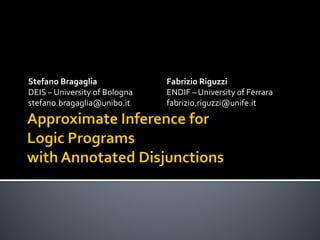Approximate Inference for Logic Programs with Annotated Disjunctions (RCRA 2009)
- 1. Stefano Bragaglia DEIS ¨C University of Bologna stefano.bragaglia@unibo.it Fabrizio Riguzzi ENDIF ¨C University of Ferrara fabrizio.riguzzi@unife.it
- 2. ? ? Increasing interest in combining logic and probability ? C1: sneezing(X): 0.7 v not_sneezing(X): 0.3 ˇű flu(X). C2: sneezing(X): 0.6 v not_sneezing(X): 0.4 ˇű hayfever(X). C3: flu(andrew). C4: flu(david). C5: hayfever(david). C6: hayfever(robert). Many formalism: ? Markov Logic Networks ? ProbLog ? Logic Programs with Annotated Disjunctions (LPADs) ? etc. ? LPADs can easily express: ? Queries: ?- sneezing(andrew). ?- sneezing(robert). ?- sneezing(david). ? cause-effect relationships among events ? possible effects of a single cause ? contemporary contribution of more causes to the same effect Example: simple medical diagnosis ? 0.7 0.6 0.88 Probability: Instances where query is true: 3 out of 4 P = 0.7ˇÁ0.6 + 0.7ˇÁ0.4 + 0.3ˇÁ0.6 = 0.88
- 3. ? Syntax ? ? ? ? ? Program: set of disjunctive clauses Head: set of mutually exclusive and exhaustive logical atoms annotated with probability values between 0 and 1 whose sum is 1 Body: event whose effects are represented by the atoms of the corresponding head 1. 2. Semantic ? ? ? Inference: in 2 steps (by cplint) Explanations: a meta-interpreter performs resolution keeping current set of choices Probability of a query: a dynamic algorithm converts explanations into a Binary Decision Diagram (BDD) and traverse it; this makes explanations mutually exclusive ?- sneezing(david). (C1;{X1/david};0) (C2;{X2/david};0) :- flu(david). :- hayfever(david). Instance: normal logic program obtained by choosing a logical atom from the head of each grounding of every clause Probability of an instance: product of the probability values of all the atoms chosen for that instance Probability of a query: sum of the probabilities of each instance where the query is true ? ? 0.4 0.3 0 XC2 XC1 0.7 0.6 1 P = 0.3ˇÁ0.6 + 0.7 = 0.88 ? Not possible in some domains
- 4. ? Best K ? Deterministic algorithm based on branch and bound technique ? Explanations built incrementally by keeping only the k most probable ones (k = 64) ? Probability of the query computed on chosen explanations trough BDD (lower bound) ? Note: limiting explanations allows better control on complexity ? Monte Carlo ? Stochastic algorithm based on Monte Carlo approach ? Instances sampled repeatedly from LPAD by considering only relevant clauses ? Head atoms of resolving clauses chosen stochastically by a meta-interpreter ? Note: the probability of the query is the fraction of sampled instances where the query is true (no BDD is needed)
- 5. ? Real datasets: 10 incremental samples of a graph describing biological entities responsible of AlzheimerˇŻs disease Biological Graph HGNC_1505 PubMed_12653 0.643 0.493 0.665 EntrezGene_11803 PubMed_15529 0.523 ? ? Artificial datasets: 3 procedurally built graphs of increasing complexity Queries: compute the probability that a path exists between two given nodes of each graph 0.567 EntrezProtein_7891032 Tests: performed on Linux machines equipped with Intel Core 2 Duo E6550 (2333 MHz) and 4 Gb RAM with a 24 hours time limit PubMed_1741124 0.602 0.621 PubMed_157782 0.713 EntrezProtein_8147603 Artificial Graphs 0.3 0.3 0.3 0.3 0.3 0.3 0.3 0.3 0.3 0.3 0.3 0.3 ˇ°lanesˇ± 0.3 0.3 0.3 0.3 ? HGNC_620 0.3 0.3 0.3 0.3 0.3 0.3 0.3 ˇ°branchesˇ± ˇ°parachutesˇ±
- 6. 12 10 8 6 4 2 0 Biological Graphs: CPU times averaged on successes 100000 Standard Best K Monte Carlo Size (edges) Time (log s) Answers Biological Graphs: number of successes 1000 Standard 10 Best K Monte Carlo 0,1 0,001 Size (edges)
- 7. Lanes Graphs: CPU times Parachutes Graphs: CPU times 100 Standard Best K Monte Carlo 0,01 Monte Carlo 0,000001 Size (steps) Size (steps) Branches Graphs: CPU times Time (log s) 100 1 1 3 5 7 9 11 13 15 17 19 0,01 Standard Best K Monte Carlo 0,0001 0,000001 Size (steps) Standard Best K 0,0001 0,0001 0,000001 1 1 23 45 67 89 111 133 155 177 199 221 243 265 287 0,01 Time (log s) 1 1 23 45 67 89 111 133 155 177 199 221 243 265 287 Time (log s) 100







